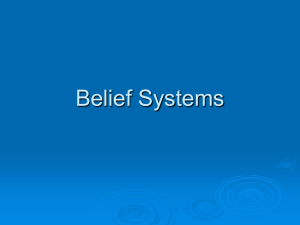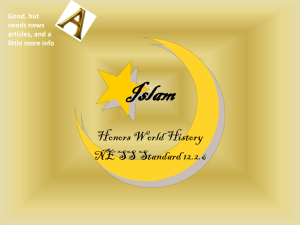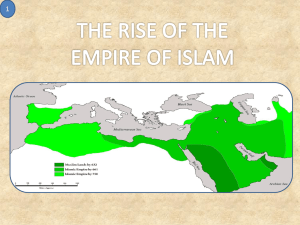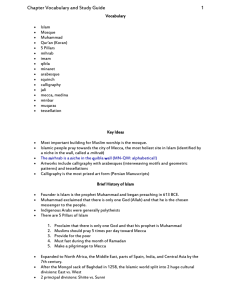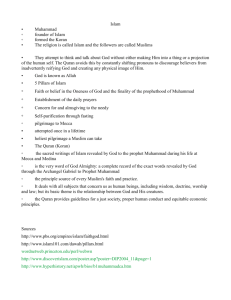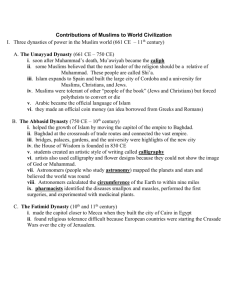Section 1 & 2 Notes - Mr. Stewart World History
advertisement
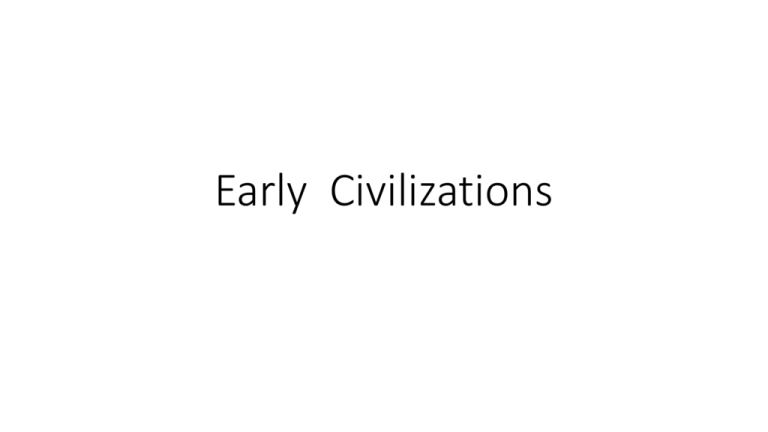
Early Civilizations Hunters and Gatherers (Old Stone Age) • Also called nomads, or people who moved from place to place. • Social structure consisted of small groups of people that traveled together. • Made simple tools and weapons, such as digging sticks and spears. • Developed a language which allowed them to cooperate in a hunt. • Began burying dead with care- maybe believed in afterlife • Buried tools and weapons with their dead. • Invented clothing made of animal skins. • Used fire for warmth and for cooking food. • Nomad • A member of a group that has no permanent home, wandering from place to place in search of food and water. • Nomadic groups whose food supply depends on hunting animals and collecting plant foods are called hunter-gatherers. • These people increased their food supply by inventing tools such as spears and knives. • The nomadic lifestyle eventually lead to the domesticated way of life, where crops were planted and animals were raised for food. • In present day, nomads still exist in places such as the Kalahari Desert and the BaMbuti rainforest. Neolithic • Neolithic revolution was around 10,000 B.C. • Environmental changes caused an end to the stone age because people could farm and domesticate animals. • People no longer had to wander to search for food but could raise their own food and live in permanent settlements. • This new age was called the Neolithic period • The new discoveries called the Neolithic Revolution or the Agricultural Revolution because the new farming discoveries changed the way people lived. Cultural Diffusion (The old stone age) • The exchange of ideas, customs, and goods among cultures. • Migration, during the old stone age people migrated into North America and other migrated to the islands in the Pacific, led to cultural diffusion. • Cultural diffusion also occurred through trade and warfare. • An example is the Sumerians, as their population and trade increased the Sumerians started coming in contact with other people. New cities were arising all over the Fertile Crescent. The Sumerians absorbed ideas such as religious beliefs from neighboring cultures. Civilization • Defined as a complex culture with five characteristics (1)advanced cities, (2)specilized workers, (3)complex institutions, (4) record keeping, and (5) advanced technology • Advanced cities: center for trade • Specialized workers: not everyone had to farm people could specialize in other areas like traders or artisans. • Complex institutions: like government need to be a lasting pattern of organization in a community • Record keeping: all civilizations have a system of writing to keep track of taxes and laws • advanced technology: new tools and techniques that are needed to solve the problems. Pharaoh • The King of ancient Egypt • The Pharaoh was considered a god as well as a ruler • This type of government was a theocracy because Pharaoh was a divine figure and at the head of government • The Egyptians believed that Pharaoh was in charge of the kingdom's well-being • He caused the sun to rise and the crops to grow • The pharaoh also was responsible for the court system and promoting truth and justice • Egyptians also believed that their kings ruled even after they had died • Pyramids were built for the pharaohs because it was believed that their eternal spirit reigned forever Fertile Crescent • The Fertile Crescent is an area of land that lies between the Persian Gulf and the Mediterranean Sea in Southwest Asia. • The Fertile Crescent is also known as Mesopotamia. • The people of which were the first to settle in this area around 4500 B.C, were the Sumerians. • The Tigris and the Euphrates rivers, which lie within the crescent, flow southeastward to the Persian Gulf. Once a year, they flood the Crescent, and it leaves a thick layer of silt, a thick mud, which keeps the land so moist and fertile. In this thick layer of soil, the farmers can plant and harvest enormous quantities of wheat barley, allowing their villages to grow. • The good soil was what attracted people to Mesopotamia, but this type of environment had three disadvantages to it • The flooding of the rivers was unpredictable, they could come as early as April, and as late as June. The floods would recede, the hot sun would dry them up, no rain would fall, and the land would become dry and desert-like. • The region was small, about the size of Massachusetts, and villages were in small clusters and were almost defenseless. • Natural resources were extremely limited, they didn’t have much to use for tools and buildings. • Sumerian Civilization (4000b.c- 500a.d) • Sumerians lived 5000 years ago in Sumer, Mesopotamia. • The Sumerians lived by the Tigris and Euphrates rivers. • Government • Each Sumerian state had a hereditary ruler who was seen as chief servant to the gods. • Religion • Each Sumerian state was believed in many powerful gods or the were polytheistic. • Most of the gods were compared to the forces of nature. • The largest buildings were temples called ziggurat's. • Economy • Their economy was based on trading. • Contributions • The Sumerians developed a form of writing called cuneiform. • They also developed algebra and geometry. • Sumerians built the worlds first wheeled vehicle and had irrigation systems, dikes, and canals. Middle Kingdom (1650 B.C.) • The Middle Kingdom was the early kingdom of China. • The geography in the region isolated the Chinese people, more so than other civilizations. • Because they had little contact with other cultures, the Chinese people believed their culture was the center of the world, so they named it the Middle Kingdom. • Most people of this region lived along the coast and in the river valleys. • Though the country had a king, clans, or large family groups, controlled the land. • The king in Shang China set up the first dynasty in China. • Social Structure: • Noble Warriors : owned land • Merchants and Craftsmen : earned a living in the cities • Peasants : largest amount of people, lived in farming villages Bantu Migration(2,000 years ago) • The Bantu refer to over 400 different ethnic groups in Africa, from Cameroon to South Africa, united by a common language family, the Bantu languages, and in many cases common customs. • About 2,000 years ago, small groups of Bantu speakers began spreading south and east. • They shared their skills with people they met on their journey, adapted their methods to suit their new environment, and learned new ways. • • Moving eastward toward the savannas they adapted their skills for herding goats and sheep to raising cattle. Passing through what is now Kenya and Tanzania, they learned to cultivate new crops. • This expanded their food supply • They followed the Congo river through the rain forests, there they farmed the riverbanks. • 1,500 years = Bantu speakers reached the southern tip of Africa • They believe the Bantu migrated because their was an explosion of food supply, which increased the population. With this increase, their was a need for food and land, so people went to search these out resulting in the migration. Classical Civilizations Zhou Dynasty Around 1027 B.C., the Zhou overthrew the Shang and brought new ideas such as the Mandate of Heaven into Chinese culture. Controlled vast amounts of land, so the government established the system known as Feudalism, in which nobles are given use of the lands that the king legally owns, in exchange for the nobles’ loyalty and military service to the king. The Chinese people gradually accepted the Zhou ways. The Zhou improved trade by introducing coined money to China, and also made advancements such as using iron in weapons and agricultural tools. The Zhou dynasty rule ended in 256 B.C. Mandate of Heaven + Used by the ancient Chinese dynasties + The belief that the right to rule is granted from Heaven + There is only one Heaven therefore there can be only one ruler. • + The right to rule is based on the virtue of the ruler. • + The right to rule is not limited to one dynasty. Han Dynasty The founding of the Han Dynasty: Liu Bang fought for the power of the dynasty against Xiang Xu, an aristocratic general Liu Bang established a centralized government in which a central authority controls the running of a state Started civil service jobs, government jobs that civilians could obtain by taking examinations to work for the bureaucracy that helped the rulers. They would test the civilians on Confucianism Han Technology Paper was invented and before this books were written on silk but paper was cheaper so it made books more able to spread Chinese education Everyone began to think agriculture was the most important so everyone began to practice it Overthrow by Wang Mang He was a Confucian scholar and member of the court he overthrew the infant leader and the Han dynasty SILK ROAD • The Han dynasty opened a trade route called the silk road that eventually linked china with lands as far west as Mesopotamia. Silk and other Chinese goods moved west, while products such as muslin, glass, and new foods came to china. The silk road stretched for 4000 miles. Few merchants traveled the entire distance. Most of the good that were traded were done at markets along the way The Gupta Dynasty (300-700) • Known as India’s Golden Age • After being invaded and defeated India needed a new leader • The Gupta family came to rule, and managed to defeat the foreigners • The Gupta's reign would last 300 years from 329 to 650 A.D • ChandraGupta I • The first Gupta who turned around India and fought off foreigners and expanded India. • The Golden Age • The golden age of India During the Gupta’s was architecture and Buddhist art. • Polis • A Greek city-state– the fundamental political unit of ancient Greece after about 750 B.C. • After the sea of peoples invaded mainland Greece around 1200 B.C., the Dorians moved in the area. Greek civilization experienced a decline during this time. By 750 B.C. the Greeks saw the rise of powerful city-states. • Made up of a city and its surrounding countryside, which included numerous villages. • Most city-states controlled between 50 and 500 square miles of territory. • In some city-states there were monarchies, however in time most adopted aristocracy. These very rich ruling families often gained political power after working in a king’s military cavalry. • As trade expanded, a new class of wealthy merchants and artisans emerged in some cities. When these groups became dissatisfied with aristocratic rule, they either took power or shared it with the nobility. They formed an oligarchy. • Athens and Sparta are famous city states. Direct Democracy • Direct democracy is a select group of people who have all the say in the government. • The people get the chance o vote for who they want those select individuals to be. • If the people chose the wrong people for the job then they would not be able to change it. • The only way to overthrow them would be to kill them. Hellenistic • Hellenistic is a Greek culture blended with Egyptian, Persian, and Indian influences. • Koine is the most popular spoken language. • This Greek culture was spread by Alexander the Great as he conqueror places like Egypt, and Persia Alexander the Great Roman Empire • The Roman Empire was founded in 753 B.C. • This republic slowly became one of the worlds most powerful empire. • Around 50 B.C. Julius Caesar took control of Rome. • Caesar soon became the absolute ruler of the Roman Empire. • Caesars biggest goal for Rome was to make it the biggest empire ever, so he would constantly invade countries to enlarge his territory. • Caesar was assassinated and his grandnephew takes over his name Caesar Augustus and brought the republic to and end thus starting the age of the roman empire this two-hundred year peace was called the Pax Romania. Pax Romana 27 B.C to 180 A.D. The Pax Romana • The period of peace and prosperity in Rome. Also known as “Roman Peace.” • The population increased during this period. • Cultural and intellectual achievements of Rome increased. Achievements • The laws of twelve tables-set of laws such as a person is considered innocent until proven guilty. • Aqueducts- bridge like structures used to carry water to long distances. • The use of arch’s and dome’s for the Pantheon. • Greek and roman culture spread throughout culture. Belief Systems Animism • An ancient religion that centralizes it’s beliefs around the belief that human-like spirits are present in animals, plants, and all other natural objects. • The spirits are believed to be the souls of dead ancestors. • Spirits possess living and non-living things • Often combined with other religions to extend beliefs. POLYTHEISTIC • BELIEF IN OR WORSHIP OF MULTIPLE GODS • THE WORD COMES FROM A ANCIENT GREEK WORD • MOST ANCIENT RELIGIONS WERE POLYTHEISTIC • OFTEN PRACTICED RITULAS AND SCARFICES TO THE MANY GODS Monotheistic Definition: a belief in a single god Greek words “mono” meaning “one” and “theism” meaning “god-worship” • The Hebrews (Jews) were the first religions to become monotheistic. They believed in one god for protection who they called Yahweh. Yahweh had power over everyone, not just the Jews and Hebrews. • God was not a physical being, and no physical images were to be made of him. • According to the Torah the treason Yahweh looked after the Hebrews was because Abraham promised to obey him, not because of ceremonies or sacrifices as seen in polytheism. HINDUISM • Started with Nomads in the Indus Valley in 1500 B.C. • Brahmah – one unifying spirit • Brahma the Creator, Vishnu the Preserver, Shiva the Destroyer • Goal of life is to unite with Brahman (through reincarnation) • Reincarnation – rebirth of the soul in a new body, get closer to Brahman with every rebirth • Karma – deeds of ones life that effect his or her next life • Dharma – moral and religious duties that are expected from an individual • Caste system – social class system • Vedas – one of the books of Hinduism, filled with sacred teachings Karma (750 B.C.) • Hindus share a common world-view. • They see religion as a way of liberating the soul from the illusions, disappointments, and mistakes of everyday existence. • Sometime between 750 B.C. and 550 B.C., Hindu teachers tried to interpret and explain the hidden meaning of the Vedic hymns. • As they meditated on the Vedas, they asked: • What is the nature of reality? • What is morality? • Is there eternal life? • What is the soul? • A belief in reincarnation, or rebirth of the soul in another body after death, forms the basis of Hinduism and underlies the entire cast system. • A person’s cast is their reward or punishment for karma, deeds committed in a previous life. • Karma influences specific life circumstances, such as the cast one is born into, one’s state of health, wealth or poverty, and so on. Caste System • This is based on what place your are in society. • The say if you are up there in the caste system, that means that you have good “Karma” Which means that you where good in your past life. • In the caste system it is good to be a male, wealthy, and a warrior. • Sometimes the caste system is bad, like if you did something really bad then you are shun and no one can talk to them. • Untouchables lowest form of the Caste System. • Reincarnation • Reincarnation is a central teaching of the Hindu Religion. • When one is born they are given life by Brahma, as they pass through life they are preserved by Vishnu, until Shiva claims you in death. • Than the cycle is repeated over and over again until one finally achieves Moksha. • Rivers are used to symbolize reincarnation because they have a constant flow, yet follow the same course. Buddhism • Originated in India, by Siddhartha Guatama • Four Noble truths• All life is suffering • Suffering is caused by desire for things that re illusions • The way to eliminate suffering is to eliminate desire • Following the Eightfold Path will help people overcome desire • Sacred text• Tripitaka- Three baskets of wisdom • Ultimate goal: Nirvana- union with the universe and release from the cycle of death and rebirth Four Noble Truths • The Four Noble Truths were a part of Siddhartha Gautama’s Buddhism. • These truths were what was understood by Siddhartha in his enlightenment. • They were ideas that were supposed to be followed to seek enlightenment, or wisdom. • The First Noble Truth- Everything in life is suffering and sorrow. • The Second Noble Truth- The cause of all suffering is people’s selfish desire for the temporary pleasures of this world. • The Third Noble Truth- The way to end all suffering is to end all desires. • The Fourth Noble Truth- The way to overcome such desires and to attain enlightenment is to follow the Eightfold Path, which is called the Middle Way between desires and self-denial. Nirvana- 250 B.C. • Belief of the Buddhist religion. • Defined as union with the universe. It is also a release from the cycle of death and rebirth. • It is also a release from selfishness and pain. • Buddha stressed that each individual person could reach a peace state called nirvana. • You have to follow the Eightfold Path in order to reach nirvana. • To achieve Nirvana, you would have to reject the sensory world and embracing spiritual discipline. Confucianism • Confucianism started in China during the Zhou Dynasty • Confucianism was the guide to the nature of government and the structure to society • Men were thought to be superior to women • Confucius wrote The Analects • Confucius believed in order to establish social order, harmony and a good government he needed to use the • Five key relationships 1. friend to friend, 2.father to son, 3. ruler to subject, 4. husband to wife, 5. older brother to younger brother • Confucius stressed that children should practice filial piety or respect for their elders • There was also an influence on the Japanese Taoism (or Daoism) bout 500 B.C. Founder= Laozi Live in harmony with nature Contemplate Tao, or the ‘way’ Yielding and acceptance are important virtues Followers rejected the world and human government, they often became hermits, mystics or poets. Balance of yin and yang Yin= earth, darkness, female forces Yang= heaven, light, and male forces Collected works: The Way of Virtue and zhuang-zi Islam(1600s – 2005) • Islam is a religion that came about in the early 1600s. • The first follower was a merchant named Muhammad Ali. • He claimed that one night the voice of Allah (God) spoke to him, and thus he began the religion. • To be a Muslim (a submitted one) or a follower of Islam, followers must obey the five pillars or five duties to Allah. • The first of the five pillars is faith – the follower must proclaimed that Allah is the one true God and Muhammad is the messenger of God. • The second of the five pillars is prayer – five times a day the Muslims must face toward Mecca (the holy city) and pray. • The third of the five pillars is alms – Muslims all have a responsibility to support the poor, which they do by giving religious tax, in money. • The fourth pillar of Islam is fasting – During the Muslim’s holy month called Ramadan the Muslims will eat nothing from dawn to sunset, and then only a simple meal to remind themselves that they should have greater priorities than bread. • The fifth pillar of Islam is pilgrimage – All Muslims who can afford it are supposed to make a pilgrimage to Mecca. • If a Muslim follows the five pillars of Mecca then they go to Heaven, if they don’t then they go to Hell. Allah • IS THE MUSLIM GOD • HE IS THE ONE GOD OF ISLAM • WORSHIPED MOSTLY THE MIDDLE EAST AND AFRICA Muhammad * Muhammad was born into a clan of a powerful Mecca Family * Muhammad took great interest in religion. When he was alone he mostly prayed and meditated. * When he was 40 a voice called to him while he was meditating. The voice was believed to say that Muhammad was a messenger of god. * In 622 Muhammad left Mecca. He went 200 miles north of Mecca too a town called Yathrib. This journey by Muhammad was known as the Hijrah. * Muhammad returned to Mecca in 630 with his 10,000 followers. * Mecca surrendered and Muhammad became leader. Most people in Mecca converted to Islam to pledge their loyalty to Muhammad. * Muhammad dies two years later at the age of 62. Five Pillars • This applies to the Islamic religion. • Faith • To become muslin, you need to testify to the statement of faith: “there is no god but allah, Muhammad is the messenger of allah. • Prayer • Muslims must face Mecca and pray five times a day. • Alms • Muslims have been taught to support the less fortunate. • Fasting • During the Muslim month of Ramadan, Muslims fast. Fasting is eating and drinking nothing from sun up to sun down. • Pilgrimage • Muslims must go on a pilgrimage to Mecca at least once in their lifetime. Christianity • Jesus Christ was the founder of Christianity. - He was born around 6 to 4 B.C. - He began his ministry at age 30. • Jesus’ teachings included many Jewish beliefs, such as monotheism and the Ten Commandments. He stressed God’s personal relationship with each person. • Jesus’ followers were called ‘disciples’ and later ‘apostles’. • Jesus was crucified around A.D. 29 for ‘challenging the authority of the Roman government’. Jesus’ disciples believed that his crucifixion was a triumph over death and that he was the Messiah. The Jewish priests of the time did not believe he was the Messiah and call his ministry blasphemy. • Jesus’ disciples continued to spread Jesus’ teachings and Christianity later became a prominent religion throughout the world. Bible • Christians used the book as a way to follow their god. • The book consisted of the old and new testament. • The bible contains stories and messages about their god. • The old testament is their god’s life as it was on earth and how it came to be. Judaism • Monotheistic – belief in one God who is present everywhere, all-knowing, all-powerful • Holy book – Torah • Writings are a sacred recording of the laws and events in Jewish history • Also writings of the prophets (spiritual leaders) • Believe that God made a covenant (agreement) with Abraham and the Hebrews to protect them • Ten Commandments from God given to Moses – laws that describe how people should behave towards God and each other • Believe that God chose the Hebrews as His people • Prophets were people who God talked to, they taught about moral standards and justice • Judaism later had a strong influence on Christianity and Islam Diaspora A Diaspora is a dispersion of a people from their original homeland. In global history we studied the Diaspora of the Jews from their homeland in Canaan (Israel) in 77 C.E. According to tradition, the Jews were given Israel by “God” in about 2000 B.C.E. In about 77 C.E., the Romans attacked Jerusalem and destroyed the temple. With Jerusalem now being controlled by the Romans, Jews dispersed throughout Eurasia in search of a place where they could practice freely. In 1948 A Jewish state of Israel was crated although many Jews still live in other parts of the World.


